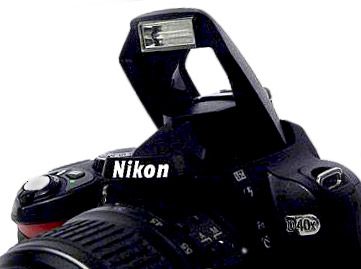
Pop-up flash needs careful use... it can be harsh and unforgiving.
Camera manufacturers will try to convince you that pop-up flash units are great. The truth is that they are pretty difficult to use. Here is what goes wrong and two solutions that will help…
Problems – Harsh Highlights, Washed-Out Colours and cut-throat shadows
Highlights are those bright spots that are complete white spots. Flash, pop-up flash in particular, is prone to create these highlights. The very small and direct light source creates harsh or hard light. Particularly on faces, highlights are ugly. The appearance of bright white areas on a face spoils shots and distorts the looks. Flash also tends to give faces a slightly blue/white tinge, making the flesh look washed out. People with faces affected by this flash effect look as if they need several good nights’ sleep. In addition, Pop-up flash is direct onto the face and in-line with the lens. This often causes a harsh under-chin shadow that slices across the neck.
Bouncing the Light
So what can you do about it? One solution is to ‘bounce’ the light from the flash. Bouncing light from your pop-up flash is easy! You need to find a way to deflect the light coming out of the flash lens. With pop-up flash it is easiest to deflect the light to the ceiling. This takes the direct light off your subject. When it hits the ceiling the deflected light bounces, which spreads it all around. This raises the light in the area you are shooting. Your shot will be brighter, but without harsh highlights. There are lots of ways to deflect the pop-up flash. However, the simplest is to buy an economical deflector. There are a number available here are two…
Professor Kobre’s Lightscoop, Standard Version Bounce Flash Device, Universal Model, fits over the Pop-up Flash of most SLR Cameras
Cateye reflector for SLRs (not Canon) Cateye LETS Flash Reflector/Diffuser Hybrid, for use with DSLR pop-up flashes
Cateye reflector for Canon: Cateye LETS Flash Reflector/Diffuser Hybrid, for use with DSLR pop-up flashes. Canon specific version
There is another, less expensive way. It is often more effective too…
Diffusing the Light
The second way to improve your image is to use a diffuser on your pop-up flash. A simple device, the diffuser is a way to spread the light out so it fills the area with light. This causes the light to bounce off a lot of nearby surfaces. The soft light that results from using a diffuser is particularly flattering. It softens shadows allowing gradual shading of the face without harsh lines or ugly highlights. The soft light from diffusers also overcomes a problem from reflectors – colour casts. With a reflector light bouncing from a coloured ceiling may pick up the colour. This can sometimes affect your picture. Diffusers are less likely to create colour casts. Nevertheless, it is important to check your LCD carefully to ensure a good colour result. Again, diffusers come in many forms. However, they are quite cheap and very easy to fit. Here are two different types – they perform equally as well and fit on most pop-up flash units. Here are two that I have been impressed with – they fit any camera…
Three Colour Diffuser: Pop-up Flash Diffuser for Nikon, Canon, Olympus, Pentax, Panasoic Lumix, Fuji FinePix, Sony Alpha, Sigma and general DSLR Cameras (with white, blue, orange)
White General Diffuser: Pop-up Flash Diffuser for Nikon, Canon, Olympus, Pentax, Panasoic Lumix, Fuji FinePix, Sony Alpha, Sigma and general DSLR Cameras
Off Camera Flash Units
An alternative is to consider buying an off-camera flash unit. These are much more controllable than pop-up flash units. They also give you a great deal of flexibility in what you can shoot and how you do it. Find out more about off-camera flash.
We would love to have your articles or tips posted on our site.
Find out more…
Write for Photokonnexion.


